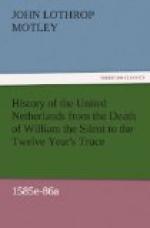It may be well understood then that the Earl’s position was a slippery one, and that great assumption might be unsafe. “He taketh the matter upon him,” wrote Morgan to the Queen of Scots, “as though he were an absolute king; but he hath many personages about him of good place out of England, the best number whereof desire nothing more than his confusion. Some of them be gone with him to avoid the persecution for religion in England. My poor advice and labour shall not be wanting to give Leicester all dishonour, which will fall upon him in the end with shame enough; though for the present he be very strong.” Many of these personages of good place, and enjoying “charge and credit” with the Earl had very serious plans in their heads. Some of them meant “for the service of God, and the advantage of the King of Spain, to further the delivery of some notable towns in Holland and Zeeland to the said King and his ministers,” and we are like to hear of these individuals again.
Meantime, the Earl of Leicester was at the Hague. Why was he there? What was his work? Why had Elizabeth done such violence to her affection as to part with her favourite-in-chief; and so far overcome her thrift, as to furnish forth, rather meagrely to be sure, that little army of Englishmen? Why had the flower of England’s chivalry set foot upon that dark and bloody ground where there seemed so much disaster to encounter, and so little glory to reap? Why had England thrown herself so heroically into the breach, just as the last bulwarks were falling which protected Holland from the overwhelming




